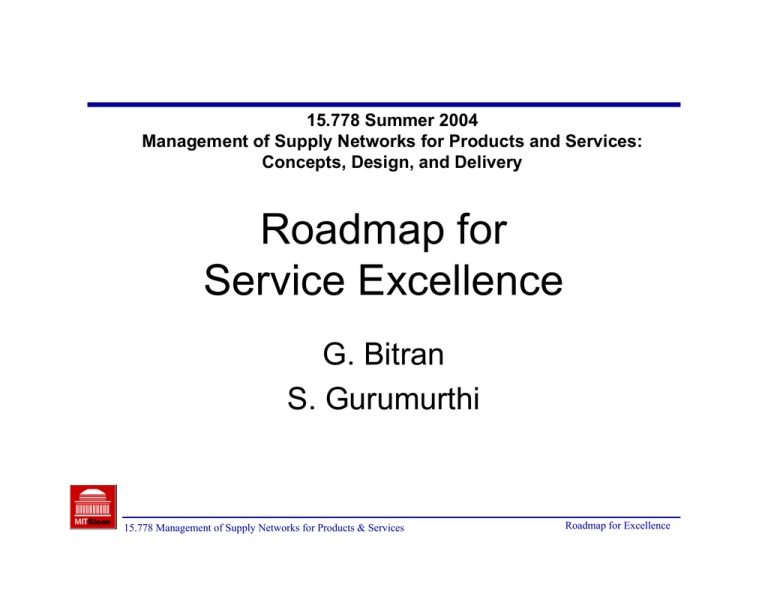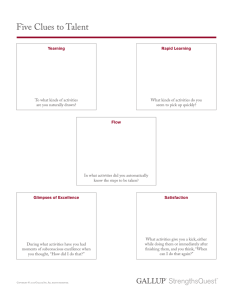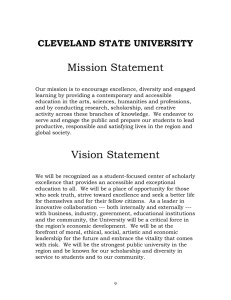15.778 Summer 2004 Management of Supply Networks for Products and Services:
advertisement

15.778 Summer 2004 Management of Supply Networks for Products and Services: Concepts, Design, and Delivery Roadmap for Service Excellence G. Bitran S. Gurumurthi 15.778 Management of Supply Networks for Products & Services Roadmap for Excellence Introduction • Excellence in services is by design, and not often by happenstance • This document provides • A framework to understand, analyze, and design service operations • A characterization of excellence in service firms and their operations • A guide to firms whose objective is to be on the frontier of excellence in their services to their customers • People Service Profit is one of the themes for excellence in services • Excellence can also be explained from first principles (we do this in depth…) 15.778 Management of Supply Networks for Products & Services Roadmap for Excellence Excellence in the Service Encounter • Service firms on the frontier of excellence understand the Service Diamond Competitive Analysis Financial Analysis Strategic Analysis Manager C on ce p t ign des Operations Management Service Management Orders Marketing Information about needs External Environment • • • • Server Service Performance Customer Resources Dec ou Backroom pling Internal Environment They are able to coordinate effectively the internal environment and the service interface They stress and emphasize different modes of management in each environment They create new services (innovate) by moving the interface between internal and external environments They understand the differences between the environments and the ways of their interaction 15.778 Management of Supply Networks for Products & Services Roadmap for Excellence People-Service-Profit (PSP) (Excellence in Defining the Firm Culture) • People in the service organization come first • – Motivated, well-trained people who have incentives to excel, can provide excellent service Service excellence – Is a direct consequence of attention to people – Customer satisfaction and loyalty are the consequence of excellence in a series of encounters between people and the customer • Profit – Is a direct consequence of excellence in service – Requires deep understanding of the relationship between service excellence and service productivity Service Excellence 15.778 Management of Supply Networks for Products & Services Service Productivity Roadmap for Excellence Excellence in Managing the Fundamentals of the Service Environment Service Attribute Attribute Detail What Best-in-Class Firms Do •Intangibility 1. Requires a grasp of the psychology of the customer. •Management of skills 2. Understanding of the importance of all the Physical Aspects associated with the service. •Superior design of facilities •Attention to appearance •Attention to presentation •Understand importance of packaging 3. The Lack of Patents •Exercise creativity to manage short life cycle of products & services. •Continuous innovation, change and flexibility in organization, free expression, incentives to think out of the box, calculated risks. 4.The need to Materialize the multiple aspects and dimensions of service being performed for the customer •Use operations and marketing to understand and emphasize the service and value-added being provided to the customer. •Communicate clearly and effectively with the customer the value-add to ensure they understand what they are paying for. Eliminates the possibility of using inventory management to match supply and demand. •Develop strategies for matching supply and demand •Revenue management and pricing •Formulate strategies for resource allocation •Resource sharing and cross-training •Focus on recruiting procedures •Cooperation with competitors •Perishability Excellence in Managing the Fundamentals of the Service Environment Service Attribute Attribute Detail What Best-in-Class Firms Do •Heterogeneity Leads to lack of Consistency in the customer service. •Training and re-training •Recruiting (best-in-class service firms are exceptional in this aspect) •Focus on retention of trained employees •Demonstrate genuine concern for welfare of Employees •Understand trade-offs between automation and human involvement in processes •Understand the need to tailor the sophistication of service strategy to customer expectations and market realities (McDonalds vs. Ritz Carlton) •Establish and adhere to processes and standards • Simultaneity 1. Services are produced and consumed simultaneously. •Demonstrate ingenuity in quality control •Manage effectively multiple sites of operation (deal with geographical dispersion and decentralization) •Realize the opportunity to share best practices •Demonstrate flexibility in the organization and develop functional processes that bring together expertise in sales, operations, marketing, quality, etc. 2. It is difficult to separate marketing, customer service, and operations in a service organization. •Seamless organization and responsive upper management. Excellence in Designing & Managing Service Guarantees Service Attribute Attribute Detail What Best-in-Class Firms Do •Potential Benefit to Service Provider 1. Service Guarantees can benefit the service provider at least as much as they do the customer. •Design of service guarantees for a “win-win” outcome. •Understand and sell the service guarantee to the service organization as a value-added proposition •Define processes around the service guarantee that minimize risk to the service organization, and that enables continuous learning •Possess ability to rapidly re-engineer processes and standards based on learning and evaluation from implementation of a service guarantee •They use the service guarantee to simplify objectives for service delivery, and unite the organization around these goals. •Are able to streamline processes towards customer satisfaction 2. Service guarantees can represent calculated risks. •Are willing to pay the penalty in order to identify fundamental problems in processes of service design and delivery •Create a culture of mutual support in the service organization in order to identify process issues in a safe manner. •Identify the risk in the guarantee as an opportunity for motivating the organization Excellence in Designing & Managing Service Guarantees Service Attribute Attribute Detail What Best-in-Class Firms Do •Potential Benefit to Service Provider 3. Present an opportunity to differentiate the service and to retain the customer for future and repeat interactions. •Understand the economics of customer retention and loyalty – customer acquisition is more complex and expensive that customer retention. •Understand the value of word-of-mouth advertising •Do not set narrow ROI performance measures for every transaction with the customer (understand the dynamic of interactions with the customer) •Potential Benefit to Customer Organization Value of guarantees to customer organization is high when -price of service is high - customer ego is on the line - expertise of customer is minimal - consequences of failure are high - perceptions of quality are low •Communicate to the customer, and materialize the service or value resulting from the guarantee to the customer •Understand the risks in the customer operating environment and demonstrate this understanding •Market the value from the guarantee as a component of the service provided to the customer •Understand the performance measures and paradigm of the customer organization and role in and value of the service to customers’ success. Excellence in Service Quality (Bridging Gaps in Service Operations) Service Attribute Attribute Detail What Best-in-Class Firms Do •Gap 1 Difference in management perceptions of customer expectations and the expected service -Lack of marketing research orientation -Inadequate upward communication -Too many hierarchies in management •Have an institutional focus on understanding customer needs through marketing research. •Ability to extract and amalgamate information from disparate sources (including internal sources) to build a clear and coherent picture of customer needs. •Have clear and well-established channels of communication from the customer to the service organization •Have clear and established channels within the organization to feed information from service encounters to the upper echelons of management •Have an environment where proximity (by role and task design) to the customer is valued rather than frowned upon as a lower-order task •Establish incentives for employees to identify customer preferences •Understand the dynamic and shifting nature of customer needs, and design appropriate processes. •Invest in IT infrastructure to capture customer preferences Excellence in Service Quality (Bridging Gaps in Service Operations) Service Attribute Attribute Detail What Best-in-Class Firms Do •Gap 2 Difference in management perceptions of customer expectations and the service quality specifications -Lack of commitment to service quality -Perception of infeasibility on the part of managers -Lack of creativity and optimism in thinking about customer needs -Inadequate task standardization -Absence of goal setting •Goals and objectives are clear and strong to overcome notions of infeasibility. •Deep understanding of the limits of the organization (positive and negative) •Ability to convert ambitious goals that appear infeasible to a series of step-by-step transitions or a trajectory of continuous improvement •Break down crucial tasks involving many changes to smaller tasks that appear manageable to service organization •Demonstrate willingness to bring in help to coach the system through the change process •Design modular tasks and roles so that change is not a cascading or disruptive event •Create incentives for service providers to participate in the design process Excellence in Service Quality (Bridging Gaps in Service Operations) Service Attribute Attribute Detail What Best-in-Class Firms Do •Gap 3 Difference between service specifications and actual service delivery -Highly interactive, labor intensive, and services in multiple locations are vulnerable to this gap -Influenced by role ambiguity / conflict, poor job-fit, inappropriate supervisory mechanisms, lack of teamwork. -Direct consequence of heterogeneity •Design tasks to be modular, and are simplified to the extent possible •Put in a series of processes to train people for everchanging tasks •Introduce change and new processes in one site, perfect the change process, and then ship it to other sites. •Establish incentives or rewards for bottleneck or mission-critical tasks •Establish clear standards for the performance of tasks (and not necessarily the performance of individuals) •Provide mentorship to new employees to perfect difficult tasks and job roles •Foster teamwork through incentives for team accomplishments •Design defect free service into the service processes— in other words, design self-reporting capabilities •Create hierarchies around problem solving capabilities (Toyota) and not around supervisory / performance roles. Excellence in Service Quality (Bridging Gaps in Service Operations) Service Attribute Attribute Detail What Best-in-Class Firms Do •Gap 4 Difference between the service being performed, and the communication to the customers explaining the service. -Inadequate communications between units of the service organization -Can also result from propensity to over-promise. -Direct consequence of simultaneity in service operations / encounter. •Possess ability to integrate the information from various functional units like sales, marketing, advertising, and service delivery, to present a common view of the service being provided to the customer •Use IT to establish a common database to ascertain status of product or service launch •Put in place processes that enable different units interacting with the customer to record, communicate, and discuss their experiences with the customer •Assign clear authority to a few individuals or a functional unit to negotiate price, quality, and guarantees with the customer in order to avoid confusion over what is being offered; however the details of the contract are made available to all. •Further empower individuals in different units to compensate customer for poor service, if necessary •Understand the quality-productivity relationship.

